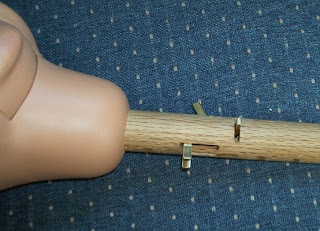First of all, doing all rod control mechanics (also called direct linkage), is an advanced technique and takes quite a bit of know how and skill to accomplish. To make direct linkage mechanics quiet and reliable is quite the challenge. I know because I have done them several times over the years I've been making figures. Here's an example of a figure I've done that way............
It turned out very nice and the customer really liked the way they
functioned and how quiet they were, but I can tell you it is a lot of
painstaking work to accomplish. By comparison, all cord mechanics are a piece of cake! Here's an all cord mechanics figure that I did recently............
It functions very nicely as well. Here is a shot of the inside of that figure, to show how simple the mechanics can be.............
Adding additional mechanics inside the head is easier with all cord control typically. Here a is a shot of the inside of another figure that had raising eyebrows added..........
All cord mechanics are easier to make and typically much easier to make them operate quietly compared to all rod control mechanics. The figure builder pulls a lot less of his or her hair out! (grin) So is all cord mechanics better in some way than all rod mechanics? Or is all rod mechanics better than all cord mechanics?
If done well, either all cord or direct linkage can be good. If done poorly, either
one can be a nightmare! Each has its advantages and disadvantages. If cord control is done poorly, the cords can fray and even break prematurely. But if done well, they can last a long time, rarely break, and operate nice and quiet. But if a cord did break at some point, the owner could most likely fix it himself, or if he sent it out to be fixed, it usually would be an inexpensive repair, which is nice.
But again, if done well the cords rarely break. Here a Chuck Jackson all cord control head stick.............
I put all new brass levers on this head stick. But I did not have to replace the cords. They were still in great shape and there was no need to replace them.
If done poorly, all rod control can end up being quite noisy and need repair soon. And if something does go wrong, it is very doubtful that the average figure owner could repair it himself. It's just too complicated. And if you have to send it out to be repaired, it could potentially be very pricey to fix. Also, you could not send it to just any figure maker to fix it. If done well however, all rod control can be very responsive, and be a delight to operate.
It would be much better to make an all cord control figure that functioned well, than to make an all rod control figure where the mechanics were very noisy, and the mechanical connections were binding/squeaking, etc.
So which is better? All rod control or all cord control? In my humble opinion, both methods are very viable ways of mechanizing and animating a professional ventriloquist figure, if..........., done well.
In the end, it can get down to personal preference as to what building style you would like to go for. My recommendation for beginning figure makers (or kit builders), is to start primarily with cord control mechanics on your first figure or two.
Then, as you get more familiar with figure building, think about experimenting with some rod control mechanics. Maybe just one or two rod control animations. The eye mechanism is the easiest rod control mechanics to learn. The mouth is the next easiest perhaps. Winkers and eyebrows can be a bit more involved.
Also, remember, a figure does not have to be all cord control or all rod control. It can be a combination of both. Over time, you will find what works best for you and your building style.







You've made a VERY valid point. I know from experience and having owned a rod controlled figure by one of today's more highly regarded vent figure builders then taking possession of a string controlled figure (made in the early 90's) by Chuck Jackson, strings won me hands down. I don't doubt they're both great, but the squeaks and stickiness of the rod figure (which cost a lot of money) can really dampen your enthusiasm :)
ReplyDeleteChuck did a lot R & D on his mechanisms (he made a machine that would test the mechanics thousands of times, to see how they would wear over time), and did the right things right. The late Rick Price worked with Chuck for a period of time, and Rick and I of course talked quite a bit about Chucks work and what we liked about it. Congrats on the acquisition of the nice Chuck Jackson figure! Have fun with him Ben!
ReplyDeleteMike
I have been building a ventriloquist dummy of a robot for a local comedy show and have run up against a problem. I can't find an example of an eyebrow mechanism that makes them point down in the middle to make an angry expression. Do you know how to modify the mechanism above to allow for angry as well as suprised? Any help appreciated!
ReplyDeleteMason . . . , send me an email at puppetsandprops@gmail.com
ReplyDelete